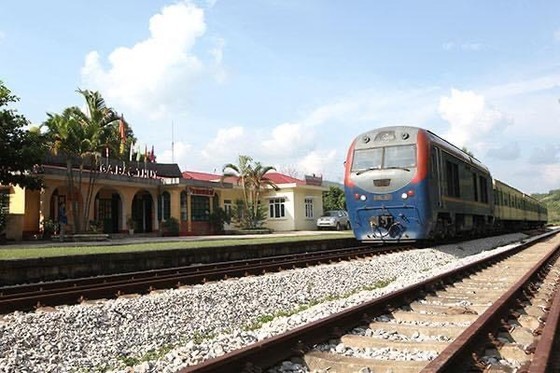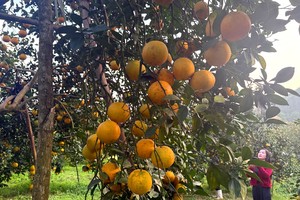 Cargo train from Hanoi to Dong Dang, Lang Son, and vice versa. (Photo: SGGP)
Cargo train from Hanoi to Dong Dang, Lang Son, and vice versa. (Photo: SGGP)
The General Department of Vietnam Customs, on the afternoon of October 7, informed the press that, due to the prolonged influence of China’s zero-Covid policy, over the past few months, the volume of imported and exported goods through the Northern border gates between the two countries has continuously declined.
The volume of goods passing through customs clearance at border gates is in drops and totally depends on the announcements of the Chinese authorities, although trade facilitation measures and the establishment of green zones and buffer zones at border gates have been deployed by localities.
In the past two years, the Government, ministries, and agencies have strived to implement many solutions to facilitate trade and promote customs clearance of goods, especially agricultural products. Up to now, many agricultural products of Vietnam have switched to official export, but the implemented solutions have not really solved the difficulties.
The railway has the advantage of smooth transportation, less being affected by the pandemic, and lower transportation costs than other types of transportation. Thus, enterprises tend to choose to transport goods by international rail carriage.
Based on the needs and recommendations of some enterprises, it can be seen that the development trend of international cargo transportation through rail carriage is inevitable. Therefore, the General Department of Vietnam Customs has suggested increasing the official export of agricultural products on railway lines.
The customs authority said that promoting the export of agricultural products by railway is also the policy and direction of the Government. At the regular meeting in February 2022, the Government asked the Ministry of Transport to lead, study, and develop a plan to improve the capacity and output of international cargo transport by rail to serve import and export activities.
The volume of goods passing through customs clearance at border gates is in drops and totally depends on the announcements of the Chinese authorities, although trade facilitation measures and the establishment of green zones and buffer zones at border gates have been deployed by localities.
In the past two years, the Government, ministries, and agencies have strived to implement many solutions to facilitate trade and promote customs clearance of goods, especially agricultural products. Up to now, many agricultural products of Vietnam have switched to official export, but the implemented solutions have not really solved the difficulties.
The railway has the advantage of smooth transportation, less being affected by the pandemic, and lower transportation costs than other types of transportation. Thus, enterprises tend to choose to transport goods by international rail carriage.
Based on the needs and recommendations of some enterprises, it can be seen that the development trend of international cargo transportation through rail carriage is inevitable. Therefore, the General Department of Vietnam Customs has suggested increasing the official export of agricultural products on railway lines.
The customs authority said that promoting the export of agricultural products by railway is also the policy and direction of the Government. At the regular meeting in February 2022, the Government asked the Ministry of Transport to lead, study, and develop a plan to improve the capacity and output of international cargo transport by rail to serve import and export activities.
 Transporting agricultural products by train is easier to pass customs clearance and has cheaper logistics costs. (Photo: SGGP)
Transporting agricultural products by train is easier to pass customs clearance and has cheaper logistics costs. (Photo: SGGP)
Earlier, Deputy Prime Minister Le Van Thanh also asked ministries, agencies, and localities to focus on implementing some tasks and solutions to take advantage of other modes of transport, such as sea and railway, to resolve container-truck congestion at the Northern border gates. Up to now, the General Department of Vietnam Customs has worked with the Vietnam Railways Administration and the Vietnam Railways and conducted surveys at Kep and Sen Ho train stations in Bac Giang Province, studying the possibility of arranging customs officers at these stations if they are upgraded to international train stations. According to the General Department of Vietnam Customs, electronic customs procedures have been implemented. Facilities, equipment, and human resources have also been fully equipped to ensure customs clearance procedures for import and export goods through the railway border gates fast and conveniently. However, the transport capacity, cargo loading/unloading services, and infrastructure at train stations have not yet met the increasing trend of transporting import and export goods by rail. Therefore, the Ministry of Finance proposed that it is necessary to invest in railway infrastructure to meet the increasing demand for the transport of import and export goods. The Ministry of Finance has recently sent an official letter to the Ministry of Transport, requesting to quickly invest synchronously in the infrastructure of railway stations and yards at Dong Dang, Lao Cai, and Yen Vien international train stations; submit to competent authorities the additional planning of Kep train station in Bac Giang Province and train stations with eligible infrastructure to become international train stations. At the same time, units outside the Vietnam Railways should be allowed to exploit railway transport to increase competitiveness, productivity, and efficiency in railway operation and transportation.
























